Oregon grape Berberis × stenophylla 'Corallina Compacta'

ABOUT
Berberis × stenophylla 'Corallina Compacta', commonly known as the Barberry, is a dense, evergreen shrub with a mounded form. Its foliage consists of small, glossy, dark green leaves that are spiky and narrow, closely packed along the arching branches. These leaves are typically quite tough and leathery, which gives the plant a robust appearance. During the spring, the Barberry boasts an impressive display of vibrant, golden-yellow flowers. These flowers are small and bell-shaped, appearing in clusters along the branches. They provide a striking contrast against the dark green leaves and can attract various pollinators such as bees. Following the flowering period, the plant may produce small, dark berries. These berries are typically blue-black in color and can add further interest to the shrub's appearance as they linger into the fall. The Barberry's branches have a thorny characteristic, with sharp spines that make it an excellent choice for defensive hedges or barriers. Its dense and prickly nature also provides good shelter for birds. With its year-round appeal from the glossy evergreen foliage, bright flowers, and attractive berries, the Barberry is a popular choice for residential and commercial landscapes. It is valued for its hardiness and low maintenance requirements, making it a suitable plant for various garden settings.
About this plant
 Names
NamesFamily
Berberidaceae
Synonyms
Coral Beauty Barberry, Corallina Compacta Barberry
Common names
Berberis × stenophylla 'Corallina Compacta'.
 Toxicity
ToxicityTo humans
The Oregon Grape may contain alkaloids which can be harmful if ingested in significant quantities. The most common issue is gastrointestinal discomfort, which may include symptoms such as nausea, vomiting, diarrhea, and abdominal pain.
To pets
Similarly to humans, the Oregon Grape can be toxic to pets if they ingest parts of the plant. The alkaloids present can cause gastrointestinal upset in animals as well, leading to symptoms such as vomiting, diarrhea, and general weakness. It's advisable to prevent pets from chewing on or ingesting this plant.
 Characteristics
CharacteristicsLife cycle
Perennials
Foliage type
Evergreen
Color of leaves
Green
Flower color
Yellow
Height
2-3 feet (60-90 cm)
Spread
2-4 feet (60-120 cm)
Plant type
Shrub
Hardiness zones
6
Native area
South America
Benefits
 General Benefits
General Benefits- Attractive Foliage: The plant has glossy, evergreen leaves that provide year-round visual interest.
- Drought Resistance: Once established, it is tolerant to periods of low water availability.
- Compact Growth: 'Corallina Compacta' has a dense, compact habit, making it suitable for small gardens or as a border plant.
- Low Maintenance: It requires minimal pruning and care, making it ideal for low-maintenance landscapes.
- Wildlife Friendly: The yellow flowers attract pollinators such as bees, and the berries can provide food for birds.
- Hardy Nature: It is resistant to a wide range of temperatures and can thrive in a variety of climates.
- Year-Round Interest: Provides visual interest throughout the year with its foliage, flowers in spring, and berries in autumn.
- Decorative Berries: Produces orange berries that add a splash of color to the garden.
- Erosion Control: Its root system can help stabilize slopes and prevent soil erosion.
- Versatile Usage: Can be used in various garden styles including rock gardens, as a hedge, or in mixed shrub borders.
 Medical Properties
Medical PropertiesThis plant is not used for medical purposes.
 Air-purifying Qualities
Air-purifying QualitiesThis plant is not specifically known for air purifying qualities.
 Other Uses
Other Uses- Photographic subjects: The Oregon Grape's striking yellow flowers and compact form make it a popular choice for photographers interested in plant and garden photography.
- Bonsai cultivation: With its compact growth habit, the Oregon Grape can be trained as a bonsai, offering enthusiasts a unique subject to work with.
- Dye production: The Oregon Grape's berries can be used to create a natural dye for fabrics, yielding shades of blue and purple.
- Culinary decoration: Although not a common food source, the berries can be used as decorative elements in culinary plating.
- Barrier plantings: Due to its dense and spiny nature, the Oregon Grape can be used to create a prickly barrier to deter unwanted animals from entering an area.
- Garden aesthetics: The deep green foliage and coral-colored berries can provide striking color contrast in rock gardens and mixed borders.
- Wildlife shelter: The dense, spiky branches offer protection and nesting sites for small birds and beneficial insects.
- Ecological education: The plant can be used in educational settings to demonstrate native plant gardening and the importance of biodiversity.
- Erosion control: The Oregon Grape's root system helps to stabilize slopes and prevent soil erosion in landscapes.
- Winter garden interest: Its evergreen leaves, persistent berries, and yellow flowers in late winter to early spring provide visual interest in otherwise bare winter gardens.
Interesting Facts
 Feng Shui
Feng ShuiThe Oregon Grape is not used in Feng Shui practice.
 Zodiac Sign Compitability
Zodiac Sign CompitabilityThe Oregon Grape is not used in astrology practice.
 Plant Symbolism
Plant Symbolism- Protection: Berberis, commonly known as barberry, has thorns that are often interpreted as symbols of protection against negative forces and as a natural barrier.
- Resilience: Barberry's ability to thrive in different soil conditions and endure harsh climates signifies resilience and the ability to withstand life's challenges.
- Sharpness and Clarity: The thorns of barberry also symbolize sharpness and mental clarity, reflecting the need for clear thoughts and decision-making.
 Water
WaterThe Oregon Grape 'Corallina Compacta' should be watered thoroughly, allowing the soil to become moderately dry between waterings. During the growing season, spring through fall, this typically means watering once every week or two, depending on the weather conditions. Supply about 1 to 1.5 gallons of water for each plant during each watering session. In the winter, reduce watering frequency to only once every few weeks as the plant's water requirements decrease. Ensure good drainage to prevent waterlogging, which can lead to root rot.
 Light
LightOregon Grape 'Corallina Compacta' thrives in full sun to partial shade. It prefers a spot that receives at least 6 hours of direct sunlight a day but can also tolerate some light shade. Avoid deep shade as it may lead to sparse foliage and reduced flowering. A south or west-facing location is ideal to provide the optimal light conditions for healthy growth and vibrant foliage.
 Temperature
TemperatureOregon Grape 'Corallina Compacta' is hardy and can withstand a broad range of temperatures. It can survive minimum temperatures down to about -20 degrees Fahrenheit and is comfortable with the heat up to 95 degrees Fahrenheit. The ideal temperature range for this plant is between 60 to 75 degrees Fahrenheit. However, it is quite adaptable and can tolerate colder and hotter temperatures for short periods without significant damage.
 Pruning
PruningOregon Grape 'Corallina Compacta' requires pruning to maintain its shape, encourage bushier growth, and remove any dead or diseased branches. Prune in late winter or early spring before new growth begins. It's often enough to prune every other year, or as needed to shape the plant or to remove any damaged stems. Cut back up to a third of the oldest stems to ground level to rejuvenate the plant if necessary.
 Cleaning
CleaningAs needed
 Soil
SoilCoral Beauty Barberry prefers well-draining soil with a mix of loam, peat, and coarse sand, ensuring good aeration and drainage. The best soil pH for this plant is slightly acidic to neutral, ranging from 6.0 to 7.0. A balanced mix will support healthy root growth and overall plant vigor.
 Repotting
RepottingCoral Beauty Barberry is typically grown outdoors and does not require frequent repotting. In a garden setting, repotting is not applicable. However, if grown in containers, it may need repotting every 2 to 3 years, or when it outgrows its current pot.
 Humidity & Misting
Humidity & MistingCoral Beauty Barberry is adaptable to a wide range of humidity levels and does not require specific humidity conditions. This plant is quite hardy and can thrive in the varying humidity levels typically found in its outdoor environment.
 Suitable locations
Suitable locationsIndoor
Not ideal for indoor growing; prefers outdoor conditions.
Outdoor
Plant in full sun to partial shade, well-draining soil, hardy and low maintenance.
Hardiness zone
6-9 USDA
 Life cycle
Life cycleBerberis × stenophylla 'Corallina Compacta', commonly known as the Coral Beauty Barberry, begins its life cycle when seeds or cuttings are planted, typically in well-drained soil and full sun to partial shade environments. Germination occurs with seeds, developing into seedlings, which, given the proper conditions, grow into young shrubs with a dense, compact habit. As the shrub matures, it produces small, spiny leaves and in spring, vibrant yellow flowers bloom, which are often followed by small, blue-black berries. The plant reaches maturity in a few years, and once fully grown, it maintains a size around 2 to 3 feet tall and wide, requiring minimal pruning due to its compact growth habit. Seasonally, leaves may turn to reddish hues in the fall before shedding, and the plant entering a dormant phase during winter. With proper care, the Coral Beauty Barberry can live and thrive for many years, successfully completing its life cycle repeatedly with seasons.
 Propogation
PropogationPropogation time
Spring
The Oregon Grape 'Corallina Compacta', a hybrid of Berberis × stenophylla, is most commonly propagated by semi-hardwood cuttings. This method is done during the late summer, typically from late July through September, when the current season's growth has started to mature but is not yet fully hardened. To propagate, healthy, semi-hardwood stems are cut to lengths of 4 to 6 inches, and the lower leaves are removed. A rooting hormone may be applied to the cut end to encourage root growth. The cutting is then planted in a well-draining potting mix, kept moist, and placed in a location with indirect light. Roots usually develop within a few weeks to a couple of months, and once established, the new Oregon Grape can be transplanted into the garden.
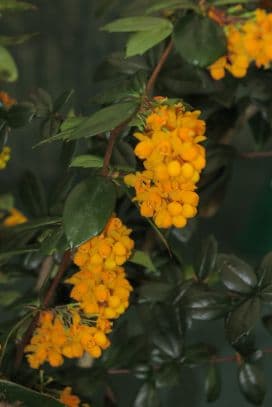
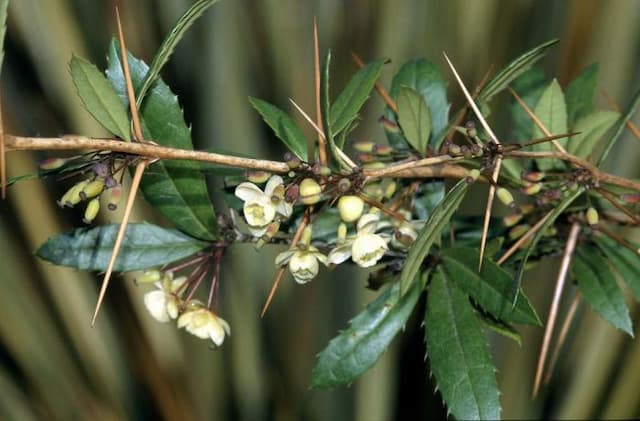
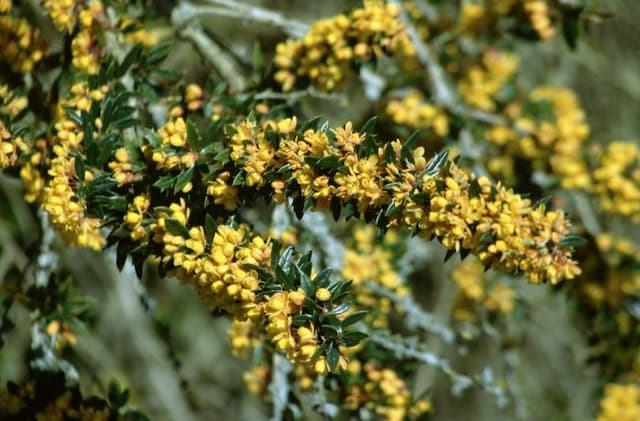
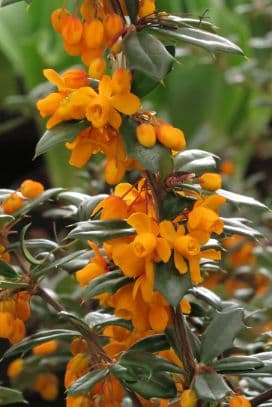
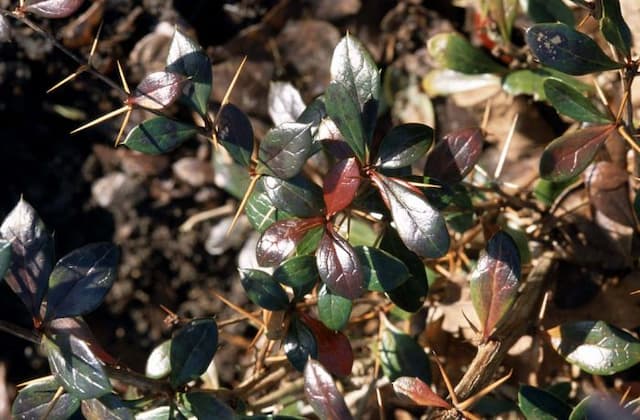


![Japanese barberry [Bonanza Gold]](/_next/image?url=https%3A%2F%2Fplants-admin.emdemapps.com%2Fimages%2Fplants%2F%2Fimages%2F604b5385e413f.png&w=640&q=75)

